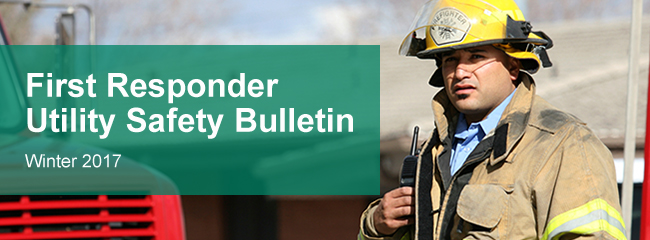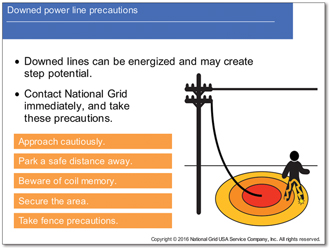Connect with us.

Winter storms and power lines: Are you prepared to respond?
Typically, for the firefighters, police and EMTs who are first on scene, understanding the risk and potential danger of electrical infrastructure contact is critical. Dealing with them correctly makes everyone safer—protecting your team, incident victims and bystanders from electricity-related injury or death. Case-in-point: Don’t become a victimA 46-year-old man was electrocuted on a tree-clearing job. The accident occurred as a hydraulic bucket came into contact with a 7,620-volt line. A worker noticed that a tire on the bucket truck was burning, attempted to move the truck, and was shocked. He was not able to let go of the door handle. The 46-year-old was electrocuted when he tried to free the worker from the door handle. (Source: St. Joseph News-Press) Downed lines are most common after storms and high winds. Therefore it’s critical that you understand electrical safety basics as well as the specifics regarding the safe response and management of situations involving downed power lines and the additional dangers when combined with winter storms. Secure the area. Look for obscured lines. Keep yourself and the public at least 30 feet away from fallen power lines. Fallen transmission lines from large towers require 100 feet of clearance. The first thing to do is to survey the area for overhead power lines, downed lines and equipment such as transformers. If you are on scene after a storm, be alert for lines that may be obscured by snow, ice, streams or standing water—any combination of which can be present during an ice storm. Protect yourself. Assume all lines are energized. Stay clear of any person or any object that is in contact with a power line. Call National Grid immediately. Don’t try to rescue the victim. Stay away until utility workers have assured you the power has been turned off. If you touch someone who is in contact with electricity, you could be shocked too. You can also be shocked if you touch the vehicle or equipment that person is in, or the tool they are holding. Shuffle, don’t run, from a downed line. The correct technique for moving away from a downed line is to shuffle with your feet together and on the ground. Fight the urge to run, and warn others not to run. Be extremely cautious when using water to fight fires near downed power lines. If you must use water, use only a mist or spray. Do not use a stream—it can create a clear path for an electric current. Train to respond safely to downed power lines during winter emergencies
Winter season natural gas safety tipsDuring the winter season, emergency responders should also be aware of the risks of extreme weather on natural gas meters, service connections and vents. National Grid advises customers and building owners and operators to make sure their gas meters are visible and accessible for emergency responders. This includes never allowing excessive snow to build up or completely cover meters, as well as taking care when clearing snow or ice from meters, pipes and vents. We also advise that air supply ducts and vents remain unobstructed and clear of snow, ice or debris: Gas equipment requires air for safe combustion and venting of appliances. If you find meters that are completely encased in ice, or if in your opinion there is a potential problem with a gas meter, please call National Grid's emergency numbers immediately. Also, be aware of overhead dangers from ice and snow falling from roofs, eaves or gutters that can cause damage to natural gas meters or service connections. The dangers of carbon monoxide poisoning are greater in winter than in other times of the year. The symptoms of carbon monoxide poisoning are similar to those of the flu. For more about CO poisoning and how to respond, check this earlier First Responder Utility Safety Bulletin. Call Before You DigRemind your colleagues, friends and the public to call your underground utility locator service toll-free at 811 well in advance of digging or moving the earth in any way. They will arrange to mark underground natural gas pipelines, underground electric power lines and other buried utilities so that everyone can work safely. Keep yourself, your team and the public safe this winter. Register today and complete your utility safety training. Visit firstresponder.ngridsafety.com.
|
||||||||||||||||||||||||||||||||||||||||||


